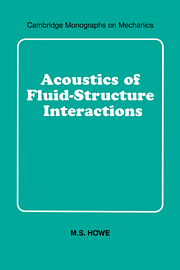2 - Aerodynamic sound in unbounded flows
Published online by Cambridge University Press: 22 March 2010
Summary
Aerodynamic Sound
The sound generated by vorticity in an unbounded fluid is called aerodynamic sound [60, 61]. Most unsteady flows of technological interest are of high Reynolds number and turbulent, and the acoustic radiation is a very small by-product of the motion. The turbulence is usually produced by fluid motion relative to solid boundaries or by the instability of free shear layers separating a high-speed flow (such as a jet) from a stationary environment. In this chapter the influence of boundaries on the production of sound as opposed to the production of vorticity will be ignored. The aerodynamic sound problem then reduces to the study of mechanisms that convert kinetic energy of rotational motions into acoustic waves involving longitudinal vibrations of fluid particles. There are two principal source types in free vortical flows: a quadrupole, whose strength is determined by the unsteady Reynolds stress, and a dipole, which is important when mean mass density variations occur within the source region.
Lighthill's Acoustic Analogy
The theory of aerodynamic sound was developed by Lighthill [60], who reformulated the Navier–Stokes equation into an exact, inhomogeneous wave equation whose source terms are important only within the turbulent (vortical) region. Sound is expected to be such a very small component of the whole motion that, once generated, its back-reaction on the main flow is usually negligible. In a first approximation the motion in the source region may then be determined by neglecting the production and propagation of the sound.
- Type
- Chapter
- Information
- Acoustics of Fluid-Structure Interactions , pp. 101 - 156Publisher: Cambridge University PressPrint publication year: 1998
- 1
- Cited by



